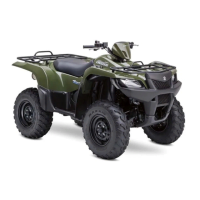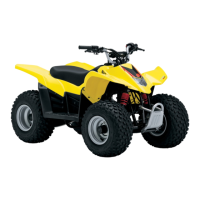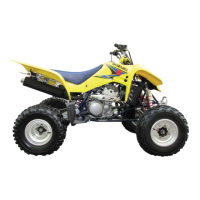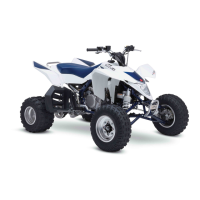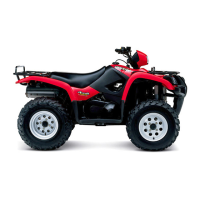ENGINE 3-25
• If the seat width
W
measured exceeds the standard value or
seat width is not uniform, refuse the seat using the seat cutter.
Valve seat width W:
Standard: 0.9 – 1.1 mm (0.09 – 0.11 in)
If the valve seat is out of specification, correct the seat by servic-
ing it as follows:
VALVE SEAT SERVICING
• The valve seats
1
for both the intake valve
2
and exhaust
valve
3
are machined to three different angles. The seat con-
tact surface is cut at 45°.
NOTE:
After servicing the valve seats, be sure to check the valve clear-
ance after the cylinder head has been reinstalled. (2-7)
• Clean and assemble the head and valve components. Fill the
intake and exhaust ports with gasoline to check for leaks.
• If any leaks occur, inspect the valve seat and face for burrs or
other things that could prevent the valve from sealing.
#
INTAKE EXHAUST
seat angle 45° 45°
seat width
0.9 – 1.1 mm
(0.09 – 0.11 in)
0.9 – 1.1 mm
(0.09 – 0.11 in)
valve diameter 22.5 mm (0.89 in) 19 mm (0.75 in)
valve guide I.D.
5.500 – 5.512 mm
(0.2165 – 0.2170 in)
5.500 – 5.512 mm
(0.2165 – 0.2170 in)
* The valve seat contact area must be inspected after
each cut.
* Do not use lapping compound after the final cut is
made. The finished valve seat should have a velvety
smooth finish but not a highly polished or shiny fin-
ish. This will provide a soft surface for the final seat-
ing of the valve which will occur during the first few
seconds of engine operation.
Always use extreme caution when handling gasoline.
15
˚
45
˚
30
˚
45
˚
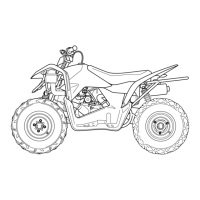
